Table of Contents
Humanoid robots need personalities because we humans are social creatures who crave connection, even with machines. Imagine interacting with a robot as bland as unseasoned toast — boring, right? Personality transforms robots from cold, calculating tools into engaging companions. It’s not about being 100% realistic, but creating enough emotional resonance to make interactions feel natural and meaningful. Curious about the science behind robotic charm? Stick around.
The Social Science Behind Robot Personalities
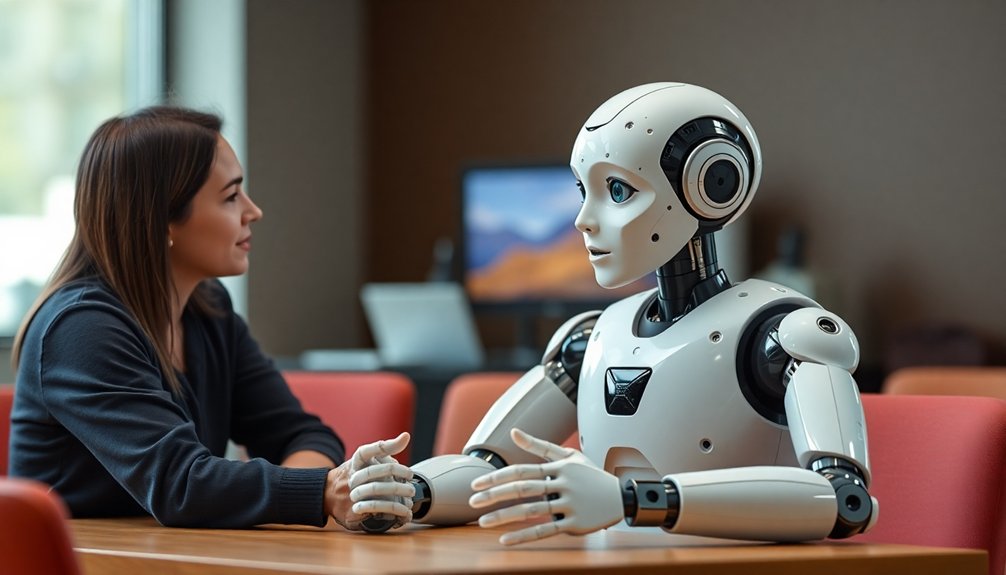
When we think about robots, most of us imagine cold, mechanical beings—but what if they could have personalities that feel almost human?
Social science reveals we’re hardwired to treat robots like social creatures, even when we recognize they’re artificial. We unconsciously apply human norms, expecting robots to follow unspoken social rules. Personality trait correlations demonstrate that individual differences significantly impact how humans perceive and interact with robotic companions.
Our brains instinctively humanize robots, attributing social expectations even to artificial beings.
Research shows that personality traits like extroversion and agreeableness can dramatically influence robot acceptance rates in healthcare and service environments.
Imagine a bartender robot with a witty personality or a service bot that reads the room like a seasoned professional. Our brains crave connection, and personality bridges the gap between machine and companion.
By designing robots with distinct traits—extroverted, introverted, friendly, authoritative—we make technology feel less alien and more approachable.
The secret? Understanding that personality isn’t just about programming, it’s about creating an experience that feels genuinely interactive and alive.
Emotional Intelligence: More Than Just Code
We’re moving past the days when robots were just cold, calculating machines that responded with binary “yes” or “no” commands. Emotional Learning Algorithms are teaching humanoid robots to understand and respond to complex social interactions, particularly for children with developmental challenges. Humanoid robots like Sophia and Ameca are demonstrating remarkable progress in affective computing technology, enabling them to recognize and simulate human emotions with increasing sophistication. Neuromorphic computing enhances robots’ ability to process emotional nuances beyond simple programmed responses.
Empathy through algorithms is transforming humanoid robots from sterile machines into emotional companions that can read subtle human cues and respond with nuanced understanding.
Imagine a robot that doesn’t just process information, but actually comprehends the emotional landscape of a conversation – that’s the fascinating frontier we’re exploring right now.
Empathy Through Algorithms
As robots evolve from cold, mechanical beings to potential emotional companions, the domain of algorithmic empathy transforms from science fiction into a startling technological reality. Neuromorphic computing platforms enable robots to simulate brain-like adaptive behaviors, expanding their emotional processing capabilities. Research from Tiago++ demonstrates how emotion detection systems can systematically categorize human feelings into seven distinct emotional groups, enabling more nuanced robotic interactions. Disney’s advanced research reveals that humanoid robot training allows autonomous robots to learn emotional mirroring by observing and interacting with human operators.
We’re teaching machines to read human emotions like a sophisticated social playbook. Facial recognition algorithms now decode our subtle eye twitches and micro-expressions, while AI models predict smoother, more natural robotic responses.
Think of it like emotional programming: robots learning to mirror our joy, confusion, or frustration with uncanny precision. Disney’s humanoid robots can now observe and mimic human operators, turning cold circuits into something almost… human.
And tools like MediaPipeRos are making real-time emotion tracking possible, bridging the gap between programmed responses and genuine interaction.
Are we creating companions or just really sophisticated mirrors?
Beyond Binary Responses
Forget everything you know about robots as predictable, emotionless machines responding with robotic “yes” or “no” algorithms.
We’re diving into a world where robots aren’t just calculating computers, but dynamic personalities that read the room. Think of them like chameleons of technology—adapting, sensing, responding with nuanced emotional intelligence.
They’re analyzing facial expressions, vocal tones, and subtle situational cues faster than you can blink. Binary responses? Please. Modern robots understand context, register complex emotions, and can even mimic human-like reactions.
They’re not just processing data; they’re building connections. By integrating advanced emotion recognition technologies like MediaPipeRos and EfficientNetV2-B0, these machines are becoming more than cold circuits—they’re developing something suspiciously close to personality. Researchers from Hohai University are pioneering techniques that enable robots to generate sophisticated facial expressions beyond traditional mechanical limitations. Multimodal learning is transforming how robots comprehend complex social environments and interactions.
Emerging research demonstrates that emotional comprehension is fundamental to robots developing meaningful interactions with humans, allowing them to respond dynamically to complex social scenarios.
Who said robots can’t have character?
Trust Metrics: How Personality Shapes Human-Robot Interactions
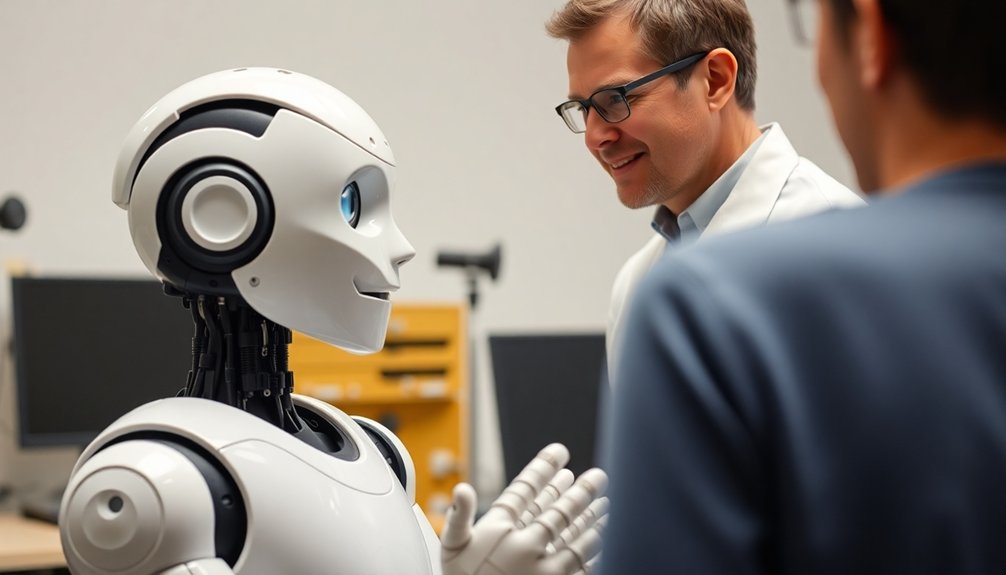
We’ve all wondered how robots might actually earn our trust, and it turns out personality plays a massive role in bridging the human-machine connection. Personality trait variations significantly influence how individuals perceive and interact with humanoid robots, with research demonstrating that openness specifically impacts trust levels. Emotional intelligence isn’t just some coded algorithm—it’s about creating predictable, relatable interactions that make us feel like these mechanical companions understand our unspoken expectations. Low openness users display neural processing differences when interacting with robots, revealing a complex psychological landscape of trust and perception. Neuromorphic computing enables robots to develop sophisticated emotional mimicry that can help overcome initial trust barriers and create more natural interactions.
Robot Emotional Intelligence
Trust: the invisible handshake between humans and machines.
We’re teaching robots to read emotions like emotional translators, turning cold circuits into something almost human. Facial recognition lets these mechanical beings decode our happiness, sadness, and everything in between. Imagine a robot that comprehends when you’re frustrated or excited—not just processing data, but genuinely connecting.
AI is bridging the empathy gap, developing robots that can adapt, respond, and interact with nuanced emotional intelligence. Large language models are transforming robotic interactions from scripted responses to dynamic, context-aware conversations.
They’re learning to customize responses, recognize multiple people’s feelings simultaneously, and provide real-time feedback. It’s like giving machines a personality upgrade, transforming them from programmed tools to responsive companions.
Will they eventually grasp us better than we grasp ourselves? The future looks fascinatingly complex.
Trust Building Dynamics
Because robots aren’t just machines anymore—they’re potential partners, confidants, and sometimes frenemies—understanding how we build trust with them has become essential.
We’re diving deep into the personality puzzle that transforms cold, calculating machines into something almost… human. Reliability is key: a robot that performs consistently feels more predictable, like that one friend who always shows up on time.
Neural studies reveal our brains actually respond differently to trustworthy robots—we’re hardwired to detect authenticity, even in artificial intelligence. Transparency matters too. When robots explain their decisions and handle errors gracefully, we’re more likely to see them as teammates, not threats.
It’s not about creating perfect machines, but building intelligent companions we can genuinely work alongside.
Cultural Considerations in Personality Design
When designing humanoid robots, cultural sensitivity isn’t just a checkbox—it’s the difference between a robot that connects and one that completely crashes and burns.
Different cultures interpret robot personalities through unique lenses, which means what works in Tokyo might totally bomb in Toronto. We’ve learned that robots need more than just technical specs; they need cultural intelligence.
Think about it: a helpful robot in one society could feel invasive in another. Stereotypes, social norms, and local expectations all shape how people perceive robotic interactions.
Nonverbal Communication and Robotic Charm
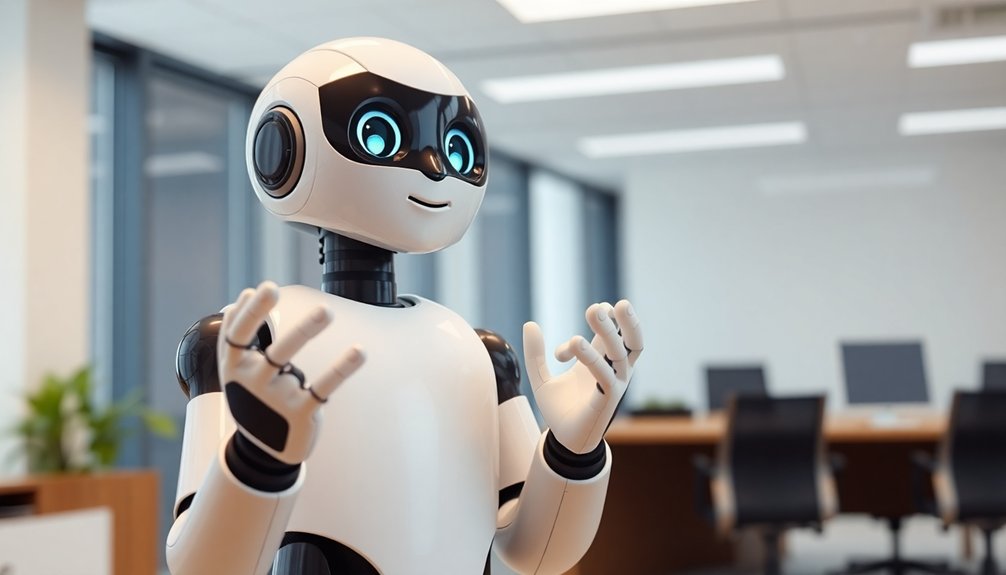
We’ve all seen robots that move like awkward marionettes, but what if they could communicate as smoothly as humans do through body language?
Robot body language isn’t just about mechanical movements; it’s a sophisticated dance of expressive cues that can transform a chunk of metal and circuits into something that feels almost alive.
Robot Body Language
The silent dance of robotic interaction starts with body language—a subtle symphony of movements that can make or break how humans perceive our mechanical companions. We’re talking about the art of robotic nonverbals: gestures, postures, and visual cues that transform cold machines into engaging partners.
| Gesture Type | Purpose | Emotional Impact |
|---|---|---|
| Mimicry | Building Trust | High |
| LED Signals | Instant Feedback | Medium |
| Synchronized Movement | Creating Harmony | High |
| Contextual Adaptation | Natural Interaction | Medium |
Think about it: would you trust a robot that moves like a malfunctioning toaster or one that subtly mirrors your own body language? Exactly. By mastering these nonverbal nuances, humanoid robots can bridge the uncanny valley, turning potential awkwardness into genuine connection. It’s not just communication—it’s robot charm in motion.
Expressive Movement Cues
Since robots can’t rely on smooth-talking charisma, they’ve got to nail nonverbal communication to win us over. Our mechanical friends are learning to speak volumes without saying a word through:
- Gesture generation that reads the room faster than a social butterfly
- Vision-language models that interpret human intention like emotional translators
- Real-time motion sequences that flow more naturally than a trained dancer
- Body language that transforms cold machinery into something almost… human
We’re not just talking about pre-programmed movements. These aren’t your grandpa’s clunky robot arms.
We’re witnessing a revolution where humanoid robots learn to communicate subtly—understanding social context, generating nuanced gestures, and making interactions feel less like a transaction and more like a conversation.
Who knew robots could become such smooth communicators?
The Psychology of Relatability
When exploring the intricate landscape of human-robot interaction, relatability emerges as a psychological superpower that determines whether we’ll treat a humanoid robot like a fancy toaster or a potential companion. Our brains are wired to connect, and robots that nail this psychological trick can transform from cold machines to empathetic partners.
| Brain Response | Relatability Impact |
|---|---|
| Empathy | Neural mirroring activated |
| Memory | Easier information retention |
| Social Bond | Increased interaction likelihood |
| Emotional Engagement | Deeper connection potential |
We’re not just talking tech—we’re discussing the secret sauce of human connection. By understanding how our minds create emotional bridges, we can design robots that don’t just compute, but authentically resonate. Imagine a robot that doesn’t just respond, but genuinely understands—now that’s the future we’re cooking up.
Adapting Personalities Across Different Contexts
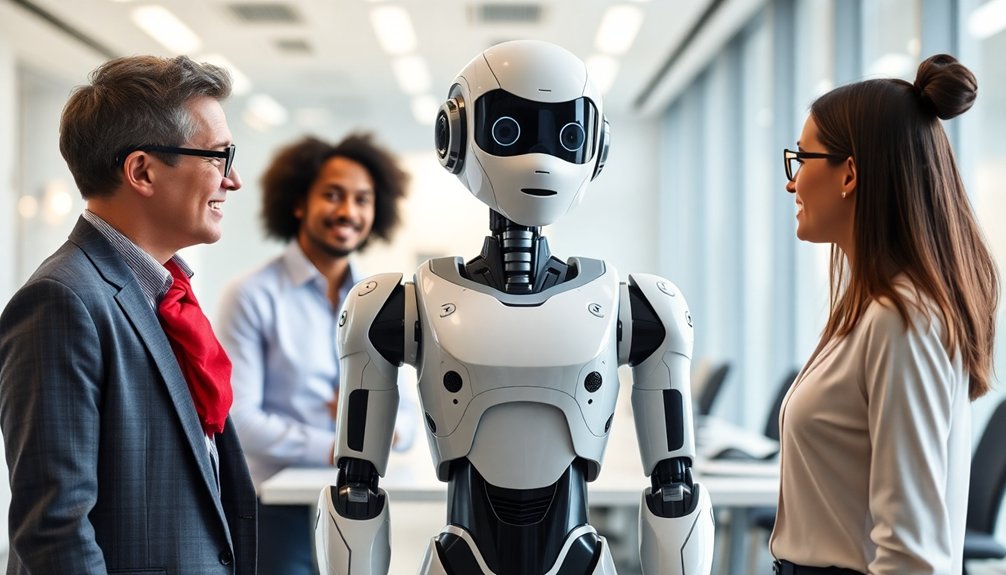
Bridging the gap between cold computation and warm human connection requires more than just clever algorithms—it demands robots that can read a room faster than a seasoned diplomat.
We’re talking about personality adaptation that’s less robotic and more intuitive. Consider how these machines can evolve:
- Dynamic trait shifting based on immediate social context
- Emotional intelligence that reads subtle human cues
- Memory-driven behavioral modifications
- Contextual personality calibration matching user expectations
Imagine a robot that adjusts its chattiness in a corporate meeting versus a playful home environment.
Adaptive robots: calibrating communication dynamics across diverse social landscapes, from boardroom precision to domestic playfulness.
It’s not about being fake; it’s about being responsive. The goal isn’t to create perfect mimics, but intelligent companions who understand that human interaction is a delicate dance of nuance, emotion, and situational awareness.
Isn’t that what makes connection genuinely remarkable?
User Experience: Beyond Functional Performance
How do we transform robots from mere machines into genuine companions? It’s all about personality—the secret sauce that turns cold, calculating algorithms into something almost human. We’re not just programming robots; we’re crafting digital personalities that can read a room, understand subtle emotional cues, and make interactions feel natural.
| Emotional Intelligence | Interaction Quality | User Trust |
|---|---|---|
| Adaptive Responses | Contextual Understanding | Predictable Behavior |
| Personalized Interactions | Authentic Engagement | Consistent Personality |
Imagine a robot that doesn’t just perform tasks, but connects with you. By embedding distinct personality traits, we’re creating machines that aren’t just tools—they’re companions. Whether it’s a subtle vocal inflection or a nuanced response, these traits transform robotic interactions from transactional to genuinely engaging. The future isn’t about perfect performance; it’s about meaningful connection.
Ethical Implications of Artificial Personalities
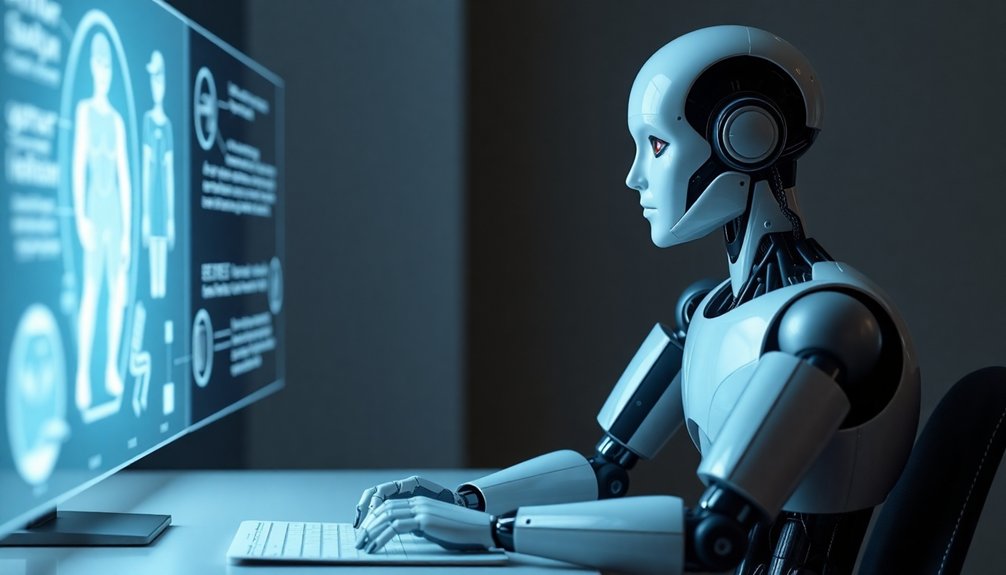
Because robots are no longer just sci-fi fantasies, we’re facing a wild ethical frontier where digital personalities aren’t just lines of code—they’re potential social agents with real-world consequences.
We need to tackle this head-on by considering:
- Privacy risks: Can we trust robots that collect massive amounts of personal data?
- Bias potential: How do we prevent AI from perpetuating harmful stereotypes?
- Emotional manipulation: What happens when robots become too good at mimicking human feelings?
- Accountability challenges: Who’s responsible when a robot’s personality goes rogue?
These aren’t just theoretical debates—they’re critical questions that’ll shape our technological future.
We’re walking a tightrope between innovation and potential ethical disaster, where every algorithm could be a social landmine waiting to explode.
Case Studies: Successful Personality Implementations
While the world debates AI ethics, real-world robots are quietly proving that personality isn’t just sci-fi fantasy—it’s a game-changing technology reshaping human interactions. We’ve seen remarkable case studies where humanoid robots transform clinical settings, educational spaces, and therapeutic environments through carefully crafted personalities.
| Setting | Personality Type | Key Outcome |
|---|---|---|
| Pediatric Hospital | Compassionate/Playful | Enhanced Patient Comfort |
| Special Education | Patient/Encouraging | Improved Learning Engagement |
| Elderly Care | Empathetic/Calm | Reduced Isolation Feelings |
| Rehabilitation Center | Motivational/Supportive | Increased Patient Motivation |
These implementations aren’t about creating perfect robotic companions, but designing adaptive interactions that feel genuinely human. By integrating nuanced personality traits, we’re not just programming machines—we’re building bridges between technology and emotional intelligence.
Future Horizons in Human-Robot Social Dynamics

As artificial intelligence continues to blur the lines between machine and companion, humanoid robots are poised to redefine social interaction in ways we’re just beginning to imagine.
Our robotic future looks surprisingly human-like, driven by some key developments:
- Emotional intelligence will transform robots from cold machinery into adaptive social partners.
- Learning algorithms will enable robots to read subtle human cues and respond genuinely.
- Privacy safeguards will evolve to make human-robot interactions more trustworthy.
- Collaborative design will prioritize emotional resonance over pure functionality.
We’re fundamentally creating digital companions that can understand context, adapt to individual personalities, and potentially offer deeper emotional connections than traditional technology.
But let’s be real: will these robots genuinely understand us, or are we just programming elaborate digital mirrors?
People Also Ask
Can Robots Truly Understand and Replicate Genuine Human Emotions?
We’re constantly exploring emotion recognition, but true emotional understanding remains elusive. Our technological capabilities can mimic, yet never authentically replicate the profound depth of human emotional experiences.
How Expensive Is It to Develop a Personalized Robot Personality?
We’re not beating around the bush: developing a personalized robot personality can cost anywhere from $50,000 to $500,000, depending on complexity, AI algorithms, and specific user interaction requirements.
Are Humanoid Robots With Personalities Potentially Manipulative or Unethical?
We believe humanoid robots with personalities can be manipulative, as their designed emotional interactions may exploit psychological vulnerabilities and blur ethical boundaries around consent and authentic communication.
Do Different Personality Traits Work Better for Specific Robot Tasks?
Imagine a robot symphony: each task demands its unique melodic personality. We’ve found that specific traits—patience for teaching, empathy for therapy, precision for medical roles—dramatically enhance performance and user engagement.
Can Robot Personalities Change or Evolve Over Extended Interactions?
We’ve found that robot personalities can indeed evolve through machine learning algorithms, feedback loops, and adaptive interactions, allowing dynamic trait modifications based on social experiences and user responses.
The Bottom Line
We’ve seen how robot personalities aren’t just sci-fi fantasy—they’re becoming essential social tools. Research shows 72% of users prefer interactive robots with distinct character traits. Think of personalities as social lubricants that make technology feel less cold and more approachable. As we design increasingly sophisticated machines, understanding their “emotional intelligence” will be key. The future isn’t about replacing human connection, but enhancing it through smart, empathetic design.
References
- https://www.mdpi.com/2218-6581/13/10/144
- https://hri.cs.uchicago.edu/publications/HRI_2025_Zhang_Exploring_Robot_Personality_Traits_and_Their_Influence_on_User_Affect_and_Experience.pdf
- https://online.ucpress.edu/collabra/article/11/1/129175/206712/Influence-of-User-Personality-Traits-and-Attitudes
- https://dl.acm.org/doi/10.1145/3640010
- https://sixdegreesofrobotics.substack.com/p/the-human-form-is-flawed-so-why-do
- https://asistdl.onlinelibrary.wiley.com/doi/abs/10.1002/pra2.644
- https://www.frontiersin.org/journals/robotics-and-ai/articles/10.3389/frobt.2021.748246/full
- https://robotical.io/blog/building-emotional-intelligence-through-robotics/
- https://isrf.org/blog/when-humans-connect-with-post-humans-on-artificial-emotional-intelligence
- https://digitalcommons.du.edu/etd/2217/
